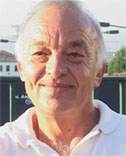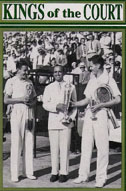The Slice Backhand
By Ed Atkinson
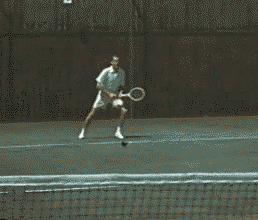
Any knowledgeable observer of professional tennis will notice that the vast majority of players are lacking an extremely valuable weapon in their arsenal of strokes-the slice backhand. The slice backhand was a basic element in the games of the greatest champions in tennis history: Bill Tilden, Don Budge, Jack Kramer, and Pancho Gonzales, to name a few.
The lack of an effective slice is one of the main reasons for the death of serve and volley and attacking tennis. It is my belief that the great champions of the past with their aggressive, net rushing style would easily dominate the one-dimensional players in the modern pro game.
Without an effective slice this attacking style of play is literally impossible, and as we shall see, there are fundamental reasons why it is so uncommon in the modern game.
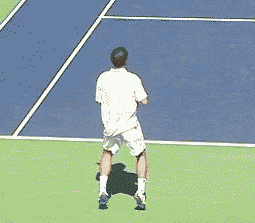
Why the Slice Backhand is So Valuable
Why is the slice so valuable? First, it is by far the best shot to use from a defensive position, particularly when a player is pulled wide off the court. In this situation the sole objective is to hit a shot that gives you time to return to the center of the court. The slice backhand is indispensable due to the fact that it travels slower than a topspin drive.
This gives the player time to get back in position, without resorting to something as defensive as a lob. It allows the player to get back into the point instead of going for a high risk winner from poor position and making an unforced error-something we see continually in the modern game.
Second, and more importantly, the slice backhand is the most effective shot to use when approaching the net-the foundation of the "chip and charge" or attacking strategy, both from the backcourt and on the return.
The Spinning Advantage
The slice approach is usually made on short balls, typically those hit with topspin, and on second serves, usually also hit with heavy spin.
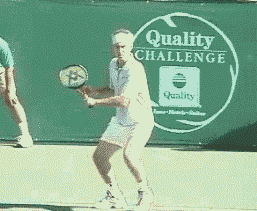
When a player slices a topspin shot, the direction of the spin on the ball is maintained rather than reversed. To understand this, imagine that as the player prepares to slice a topspin shot, the top of the ball is spinning toward him as the ball approaches. As he slices under the ball, the ball continues to spin in the same direction. That is, as the ball leaves his racquet and travels back toward the opponent, the top of the ball is still spinning towards him.
By changing topspin into underspin, the player actually adds to the existing spin on the ball. This causes the ball to skid and remain low in the opponent's court. The player is forced to hit up as you assume your position at the net.
The slice approach is particularly effective on grass and other fast surfaces, which cause the bounce to remain even lower than on slower surfaces.
It is no accident that modern Wimbledon champions such as McEnroe, Edberg, and Sampras, all utilized the slice backhand with great effect. It is also no accident that these players all had one-handed backhands.
The slice backhand is virtually impossible to hit correctly with two-hands. Even two-handers who try to add the one handed variation are never as natural and sure.
Hitting the Slice
The grip should be the eastern backhand, with the wrist slightly cocked. The stance should be sideways to the net with the feet parallel at approximately shoulder width.
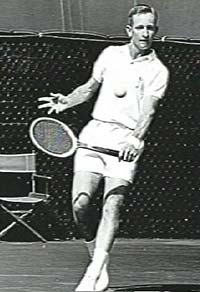
The swing is diagonal from high to low, ending with the racquet pointing toward the net. The ball should be struck as far in front of you as is comfortable. The angle of the swing varies depending upon the amount of underspin you wish to create.
A player such as Don Budge or Ken Rosewall could drive through the ball with slice, penetrate the court, and even, in Rosewall's case, hit effective passing shots.
The most essential element of the stroke is that there is no break in the wrist or forearm at contact. Starting from the cocked position on the backswing, the racquet is thrust forward until the arm is completely straight.
Chip and Charge
When using the slice approach, it is critical to remain as still as possible when contacting the ball. Obviously to make an approach shot you must run forward toward the short ball. A prevalent mistake is to run up to the ball and hit without stopping. This error can be fatal. The momentum of your body combined with the speed of the oncoming ball turns an easy opportunity into a very difficult shot. So remember, run, plant (your feet), and hit.
It is my belief that the chip and charge should be used virtually every time your opponent hits a second serve. This tactic was a staple of the great serve and volley players like Kramer and Rod Laver, as well as many others in the golden age of grass court tennis.
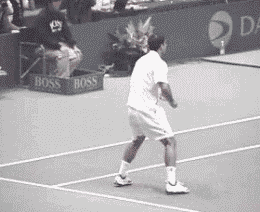
But the chip and charge is vastly under utilized in the modern game. Why? It is here that I must vent my spleen against what I consider the greatest disservice to men's tennis in its history-the increasing dominance of the two-handed backhand.
Yes, the two-handed shot allows one to hit greater crosscourt angles and is, perhaps, more difficult to read. So much for the good news.
The bad news is that it reduces the players' reach, a weakness that is graphically exposed in the return game. Worse, it keeps players from developing a natural slice backhand, which reduces the ability to play good defense, and virtually eliminates the ability to chip and charge or play serve and volley (See The Golden Age of Serve and Volley, by Ed Atkinson).
If the bad news exceeds the good so dramatically how did the two-handed backhand reach it's present popularity?
The answer is that children are introduced to the game at a far too early age. This phenomenon is exacerbated by the fact that present racquet construction makes racquets too heavy in the head. When an infant is required to hit a backhand drive with a head heavy racquet, the only alternative is to use two hands.
No child should commence playing tennis before the age of ten-at the earliest. There have been great champions who started playing in their teens. Once a player is strong enough to develop a one handed backhand, he can develop the serve and volley and the chip and charge tactics.
With the correct technique, the chip (slice backhand) is safe and effective, and the tactic puts enormous pressure on your opponent.
This pressure only increases as the match wears on. Your opponent will attempt to hit his second serve harder and/or deeper, engendering double faults. To hold serve, he will be forced to hit the most difficult shot in tennis-the passing shot-on a repeated basis.
To some this strategy may appear extreme, yet it was the preferred tactic of the greatest champions the game has ever seen. Use the slice backhand to create a relentless attacking style and you too will reap the benefits of the old adage: "Fortune favors the bold."



